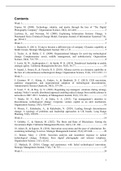Samenvatting
MTC summary
- Instelling
- Rijksuniversiteit Groningen (RuG)
Learning Objectives Upon completion of the course students are able to: 1. Understand and explain the relations between technology (IT in particular) and organizational and strategic change; 2. Use various theories and models to understand and explain technology adoption and resistance at the ...
[Meer zien]




